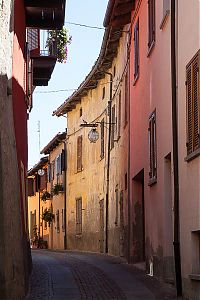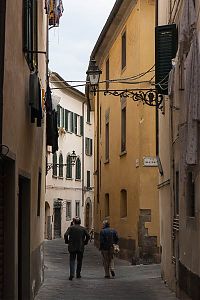
 I have always wondered why I feel compelled to take pictures like you see on the right. Houses stuck together, a gentle curve, a bit of sky.
I have always wondered why I feel compelled to take pictures like you see on the right. Houses stuck together, a gentle curve, a bit of sky.
What I was really trying to get at, of course, was the fundamental question: “Why in heaven’s name do we think of Medieval towns as romantic?
I thought, “It has to do with that picture, somehow.”
I think I was right. What you see is, in every sense, romantic. When you are in the street it is enclosed. It embraces you. There is still light, of course. Not harsh, “you look like a ghoul” kind of light, but light that is gently filtered and plays itself out in gentle gradients with the curvature of the buildings.
Enclosure. Think about that word. The town embraces you. The pathways are organic; they come about as a response to the earth as it stands, not the earth as we can wrestle it into a preconceived form so we can feel safer or drive faster.
I believe that the informal, irregular street arrangements often arose when paths turned into streets as people began to erect buildings along them. In hilly country, paths that have been beaten by humans and animals usually hold the maximum grade to near its lowest practical value. In so doing, they follow the contours of the site. In flat terrain, drainage features and soft soils similarly constrain the location of paths and usually favor firmer soils and drier sites.
Beaten paths usually take interesting and pleasant shapes. The course of a beaten path is almost never straight but is by no means random. Many things come into play, and even among humans the mechanisms are mainly unconscious.
That’s J.H. Crawford’s riff on the subject in A Brief History of Urban Form:
Street Layout Through the Ages
Crawford points out that the ancient and modern rigid grid system can’t possibly be romantic:
Straight streets and the grid often express the power of a ruler and his will to impose his chosen order.
 So that explains it. Who wants to be skewered by the imposed will of a strong ruler, or taken for the ride on the hood of a car whose driver imposes his will at one of the many, many intersections one has to cross in a modern rigid-grid planned city?
So that explains it. Who wants to be skewered by the imposed will of a strong ruler, or taken for the ride on the hood of a car whose driver imposes his will at one of the many, many intersections one has to cross in a modern rigid-grid planned city?
We want to be embraced, coddled, lost in the soft, filtered light and gentle curves of the path made into a street. We want to explore the mystery of the tunnel without a glaring light at the end of it. We want, perhaps, for a place to move us.
I wonder what becomes of people who’ve never experienced a Medieval city? After all, grids (an ugly word, no?) have been imposed upon almost everyone since the Renaissance. Does one lose hope? Does one’s soul harden into hatefulness? Could it be enlightening to be surprised by the immensity and beauty of a Baroque church dome as you gently crest a rise in your beautifully enclosed street?
We all need to travel, don’t we? That and a little wine, I think. Then perhaps we’d move on to Roman Roads
